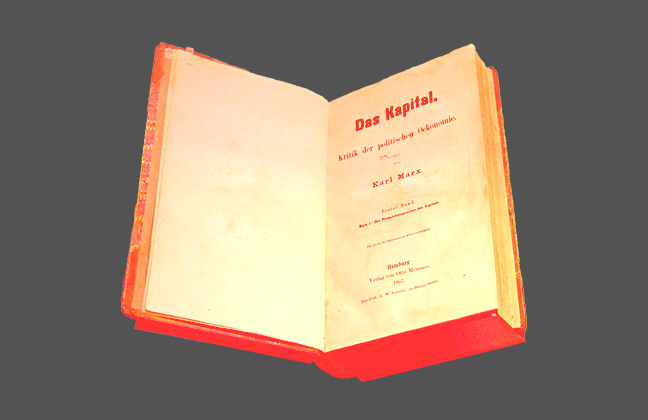Lecture 9: The production of absolute surplus-value
The capitalist exploitation of the working class is the consumption of the worker’s labour-power. This can only take place in the capitalist labour process, that is, under capitalist conditions of production, in capitalist industry.
The capitalist labour process is a form of the more general labour process, the production of use-values which is indispensable for human existence. The simple elements of the labour process are:
- labour-power (Marx says purposeful activity or work but this is not a factor rather a phase of the labour-process – Emmett)
- the object on which that work is performed and
- the instruments of labour.
The object of work may be a natural product eg fish in the sea, wood in a virgin forest, or a raw material. The latter is something that has been prepared for industry by previous labour such as caught fish for a cook or iron ore for steel making etc. Instruments of labour are those things which human beings interpose between themselves and the objects of their labour and which serve as a conductor of their activity.
In the labour process the activity of human beings, using the instruments of labour, brings about an alteration in the object of labour and thus adapts it for human use. The product is a use-value: ‘Nature’s material adapted by a change of form to the wants of man’ (p180).
The means of production consists of both instruments of labour and objects of labour. Also auxiliary materials such as dyes, lubricating oils, coal for engines and food for animals. Sometimes a labour product can serve as raw material for its own production such as wheat for sowing. The means of production are generally of no use unless they are consumed in the labour process. Labour is the process of consuming the means of production. Such consumption is called productive consumption. This is to be distinguished from the individual consumption of the worker which is the means by which the worker may live. The labour process as just presented is a Nature-imposed condition of all human existence, common to all forms of society in which human beings exist (p183-4).
We now return to the capitalist. Under capitalism the labour process is turned into a process in which the capitalist consumes labour-power by putting it to work consuming the means of production. It exhibits two characteristic phenomena:
- The labourer works under the control of the capitalist to whom his/her labour belongs.
- The product is the property of the capitalist and not that of the labourer the immediate producer (p184-5).
The production of surplus-value (Verwertungsprozess)
Use-values are produced under capitalism only because they are depositories of value. The aim of the capitalist is to produce commodities whose value is greater than the value of the means of production and labour power bought and used up in their production. That is, the capitalist’s aim in the production process is ‘surplus-value’.
The conversion of the labour process into a commodity producing process is at the same time a value-creating process. And just as all the factors of the labour process enter into the production of use-values: so in the production of value, the pre-existing values, in the consumed instruments of labour and raw materials, enter into the value of the new commodities. Marx then goes on to show us through an example of yarn production the difference between production of use-values and capitalist production. He goes on to show how surplus-value is produced. (Example p186-193)
First he points out that the labour required for the production of the cotton, the raw material of the yarn, is part of the labour necessary to produce the yarn, and is therefore contained in the yarn. The same applies to the labour embodied in the spindle, without whose wear and tear the cotton could not be spun. The values of the means of production ie the cotton and the spindle, are therefore constituent parts of the yarn or the value of the product. (In Marx’s example of the production of 10 lb of yarn, equal to 20 hrs or 10s for the cotton raw material and 4hrs or 2s for the wear and tear of the spindle).
Added to this is the cost of the labour power put to work to spin the cotton into yarn. (In Marx’s example the daily value of labour power is 3s and it takes 6 hours to produce 10lb of yarn which has a value of 15s ie 10s + 2s + 3s. Such a result would mean that if the yarn were to sell at a total price of 15s no surplus- value for the capitalist).
Marx then goes on to consider the capitalist justifications for surplus value.
First that the capitalist advanced money for the purpose of making more money. But the best of intentions are no claim on surplus-value. The capitalist threatens not to manufacture but buy yarn in the market ready-made. This will not give him any surplus-value.
The capitalist has practised ‘abstinence’ by not destroying value. This will not give him a claim to surplus-value and as a result of his abstinence he still possesses his value.
That the capitalist has rendered a ‘service’ to society as society consists of the poor and the labourer has been supplied with means of production. But such a service is no claim to surplus-value. Has not the labourer ‘served’ him with yarn and besides a ‘service’ only means use-value and we are concerned with value.
Finally the capitalist has laboured at overseeing the labourer. But overseeing the labourer create value does not itself create any value.
Marx says the capitalist leaves all this nonsense to the paid professors of political economy and being a practical person knows perfectly well at what he is about. The real facts point to something else as the basis of surplus value.
First, the past labour embodied in labour-power, and the living labour it can call into action; the daily cost of maintaining it and its daily expenditure in work are two entirely different things. The former determines its value, the latter its use-value. (The fact in Marx’s example that the labour of half a day – 6hrs – will keep the labourer alive for 24 hrs does not stop him/her working longer).
‘Therefore, the value of labour-power, and the value which that labour-power creates in the labour process, are two entirely different magnitudes; and this difference of the two values was what the capitalist had in view, when he was purchasing the labour power.’ (p193)
What interested the capitalist was the specific use-value which the commodity labour-power possesses of being ‘a source not only of value, but of more value than it has itself.’
Surplus-value is produced because the capitalist only pays for part of the labour performed – the equivalent of the value of the labourer’s labour-power – and leaves the other part unpaid for. That is when the labourer has performed the labour corresponding to the value in the labourer’s payment he is not by any means finished with. (In Marx’s example the labourer now works a full day of 12 hrs, 20 lbs of yarn are produced costing 27s and having a value of 30s). It is this labour process under capitalist production which converts money into capital.
Every condition of the problem has been satisfied. The laws which regulate the exchange of commodities have not been violated and equivalent is exchanged for equivalent. The conversion of money into capital takes place both within the sphere of circulation and also outside of it; within circulation because conditioned by the purchase of labour power in the market; outside of it because what is done is a step towards the production of surplus value (der Verwertungsprozess) which is entirely confined to the sphere of production (p194-5).
We can now see the difference between production, the labour process pure and simple and capitalist production. Production means the production of humanity’s needs for living; it is a Nature-imposed necessity, an indispensable condition for human existence. Commodity production is a combination of this process with value production: an intermediate stage between production and capitalist production. Capitalist production is a combination of this nature-imposed labour process with the production of surplus-value. It is a process in which the worker has ceased to be in control and in which the product has ceased to belong to the worker. It is, in short, the capitalist exploitation of the working class, and the resulting embodiment of surplus-value in commodities.
Marx goes on to show that it makes no difference to the fact of the creation of surplus value whether the labour employed by the capitalist be skilled or unskilled labour. Skilled labour will produce more labour than unskilled labour in a given time.
‘All labour of a higher or more complicated character than average labour is expenditure of labour-power of a more costly kind, labour power whose production has cost more time and labour, and which therefore has a higher value than unskilled or simple labour-power. This power being of a higher value its consumption is labour of a higher class, labour that creates in equal times proportionally higher value than unskilled labour does.’ (p197)
And just as with unskilled labour it will produce surplus-value by the extension of the labour time past the point when the worker has replaced the value of his/her own labour power. As skilled labour can be reduced to average social labour eg one day of skilled labour to say six days of unskilled labour we can simplify our analysis by assuming throughout that the labour employed by the capitalist is unskilled average labour.




